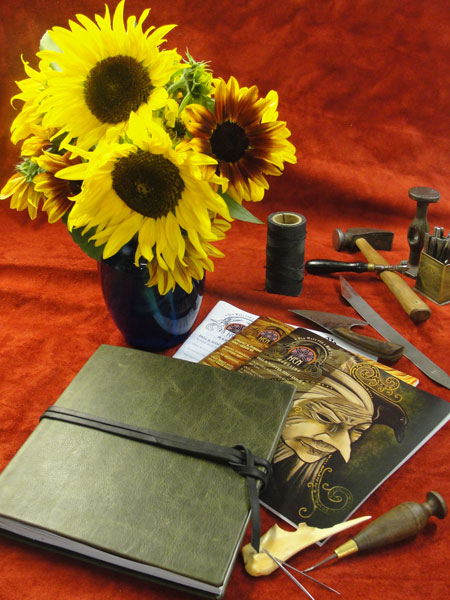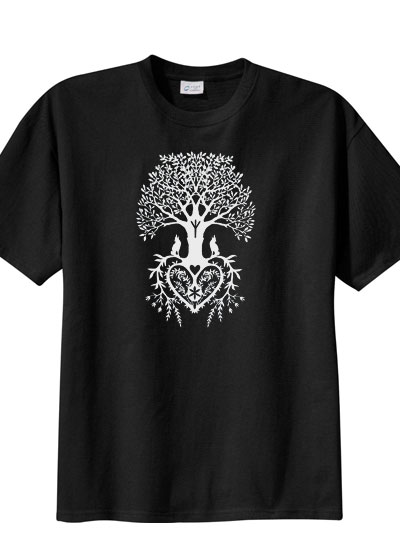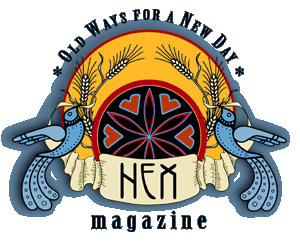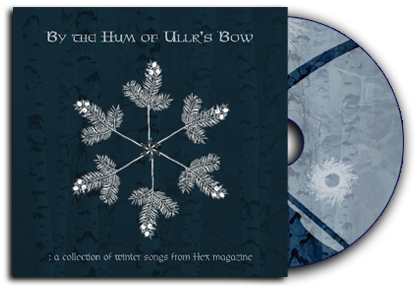~ THE TURNING OF THE WHEEL~
Autumn Equinox 2013
Leather Bound Limited Edition of Issues #9–11!

An edition of 13, and signed by the artisan (Jason Hovatter)
and editors of Hex.
These are the final three issues of Hex in its original twice-yearly format, bound in an exquisite leather folio.
Chock full of inspiration, history, good food, and myth!
Issues 10 and 11 are sold out and only available in these beautiful editions.
Pre-order your copy for $75 + shipping. Shipping date is October 1.
Learn more and order yours at
http://hexmagazine.com/shop/products/hex-leatherbound-9-10-11/
It’s first come…first serve.
* * * * * *
Tree of Life T-Shirts!

In response to popular demand, Arrowyn Craban Lauer presents her Tree of Life artwork (from the cover of Hex Issue 7) on t-shirts!
Available in the following styles (black fabric only):
Men’s: 4.3 oz 100% Combed Ringspun Cotton.
Super-soft, lightweight, slim-fit tee.
Machine washable and preshrunk to minimize shrinkage.
Side-seamed for a tailored cut.
Women’s: 4.3 oz 100% Ringspun Cotton.
Super soft with a slight stretch for a perfect fit.
Longer length, slightly scooped neck, fashionably shorter sleeves.
Women’s: Tank Top: 3.2 oz., 100% cotton sheer jersey spaghetti strap tank top.
Feminine fit, longer body length.
Pre-order your t-shirt for $18 + shipping. Shipping date is October 1.
Order yours at http://hexmagazine.com/shop/products/category/clothes/
* * * * * *
Hex Cookbook Project
We are now Accepting Submissions for the Hex Cookbook Project! Thistlemoon (aka The Leftover Queen, http://www.leftoverqueen.com) and Hex’s own Arrowyn Craban Lauer are putting together a cookbook full of seasonal and traditional European recipes.
We want your old family recipes, traditional favorites, or recipes with a modern twist on a traditional theme. We would love recipes that come with folklore, family stories, or historical background about the dishes or their ingredients. Bonus points if you have wisdom to share about traditional nutrition, farming practices, and the like!
Please only submit recipes to which you hold copyright, or which are in the public domain. It is acceptable to submit recipes that are inspired from published ones, but you will need to credit to the original.
Check our recipe guidelines and send your submissions to: recipe@hexmagazine.com.
* * * * * *
Feeling Hexy?
Hex is putting out an initial call for Heathen Erotica. For a side project, not a regular issue. It will be published when we get enough material.
Accepting submissions for stories, poetry, art, photography, recipes, whatever. You can submit under your own name or a nom de plume. The usual high standards of quality apply! IE: if it’s smut, it better be really good smut!
Send submissions to submissions@hexmagazine.com
* * * * * *

• Ingwaz •
Old English Rune Poem
Ing was first with the East-Danes
seen they say, until he later east
over the sea departed; wagon followed after;
thus warriors named that hero
~ Rune poem translation by Sweyn Plowright
http://www.mackaos.com.au/Rune-Net/Primer/
Old English Rune Poem
Ing was firstly in East Denmark
observed by soldiers ‘til he later east
on his way did go, wain after came.
Thus the hardened ones then the hero called.
~ Rune poem translation by Gary Stanfield
http://runicwisdom.info/rwtoc.htm
I have provided two different translations for this poem as Stanfield argues convincingly that we should read the first part of the third line as “way” and not “sea.” For an in depth discussion, readers are invited to check out his web site and book (which is a free download and a great read). Sweyn’s translation nonetheless tickles my toes, even if he might have been led astray on the “sea” thing. But enough of matters philological!
For me this rune illustrates a distinct kind of transformational process, a cycle of systole and diastole, to pinch a thought from Goethe by way of Jung. We go out, we return to the within. Or, read psychodynamically, we voyage within in order to enrich our everyday consciousness.
The “journey beyond” is one of the fundamental elements of mythology, be it Germanic or otherwise. The hero who goes beyond the bounds of consensus reality, confronts the mystery that lurks beyond, and returns transformed, gifted with the power to revivify his land of origin, to infuse it with the wisdom of the Other. This idea, that it is valuable to meet with the Other and sometimes even to adopt their influence, is disturbing for some Heathens. Here’s why.
In the 19th century, the roots of what could be called “first phase” germ theory emerged. The early emphasis was on pathogens – dangerous bugs that scientists began to realize were everywhere. The distinction was drawn been contaminating bacteria and wholesome organisms. The germ war began in earnest once we had penicillin and Pasteurization.
Fast forward to the present: we have created armies of superbugs that defy all drugs. Our immune systems are falling apart because they evolved to deal with a much more difficult microbiological environment than the one that our chemical blitzkreig has created. Translation: without anything to keep our immune systems in check, we’ve started cannibalizing ourselves. The uncontrolled auto-immune and allergy epidemic is the result.
It now seems, at least according to Michael Pollan, that 90% of our cells are bacterial, and 99% of our DNA is the same (yes I know, this is staggering to think about, and Pollan’s newest book, Cooked, is a wonderful read).
Human beings, indeed probably all multi-cellular organisms, are not pure, unitary entities. We are vast colonies of varied little beasties. Symbiosis, not rigid armor or endless conflict, is the law of life, the condition of our existence.
But our consciousness is so heavily shaped by the 19th century germ paranoia that we continue to project it everywhere in our lives. Thus the ancient Heathen respect for the hero who embraces the unknown, and returns to enrich his people with its wealth of mysteries, is easily lost on we contemporary folk. We have a badly impaired notion of balance, of dynamic equilibrium.
Yet if we consider that our bio-psycho-social makeup is that of a multi-faceted micro-organic colony, then we might re-evaluate our relationship to ourselves. We might discover that we are as an unknown country, an enigmatic horizon. The arrogant, dualistic ego (so emblematic of 19th century germ paranoia) is radically re-contextualized. We need to conduct inner, psychological, journeys in order to foster communication and harmony among the myriad mysterious biological forces that compose us.
In my mind, for some reason, the Ingwaz rune poem implies that the hero also returns, though this is purely my own conjecture. He is a hero among warriors, among “hardened ones,” because of his brave reaching out to the unknown, the beyond, the within. The “east,” mythologically speaking, refers to the Utgard, to the realm of the giants. It refers to other worlds, other lands.
To consider this psychologically – when we begin to take a little time and attune to our dreams, thoughts, and feelings, we find ourselves confronted with so much material that is both intimate and alien. So long as we have a 19th century germ paranoia mentality shaping our attitudes to ourselves, others, and the wider world, we are denied access to our deeper truths.
Indeed, to complete that line of thought, the urge to reject the Other is just as much a resistance of accepting the self. And as Phil Hine so beautifully put it, “a god denied is a devil created.” In Narrative work they say that most psychological problems occur because of unfinished conversations. There’s something very profound in that; but a conversation cannot occur unless there is both Self and Other, both known and unknown.
Graphically speaking, Ingwaz resembles a very simple four-fold mandala, a near-universal symbol of psychological wholeness (Jung documents the vast reach of the symbol across time and space most comprehensively). The completion of the fourfold is only possible when the inferior quadrant – the repressed and the unknown – is allowed equal status to the other three points or directions.
Thus a truly secure “inangard” is only achieved once the “utangard” is encountered, accepted, and reconciled with what is already familiar. Frey, of whom “Ing” is likely a byname, understood this principle, which is expressed in his wooing of the giantess Gerd, who dwells far beyond Asgard’s walls. Ingwaz articulates one of Nietzsche’s better-considered observations: strong cultures are permissive, weak cultures are restrictive.
To truly know ourselves and be assured of ourselves we must let go of our tight-fistedness (generosity and hospitality were the two highest virtues in Heathen times). The first place to begin this releasing is in our relationships to ourselves. If we do it right, floodtides of living wealth might begin to flow from us, and the promised superabundance of the Aesir and the Vanir might begin to make itself present in our shadowy, coiled up lives.
Of course, to blame our predicament on the faulty yet pervasive assumptions of the germ warfare mentality is simplistic. Germ paranoia emerged in the context of other social forces – class conflict, colonial depredations, and other macrocosmic clashes between ego and mystery. It is up to each of us to resolve this binary dispute within ourselves – that is Ingwaz’s teaching. Woe to those who cannot see beyond one extreme or the other.
* * * * * *
By the Hum of Ullr’s Bow: Winter Songs Compilation CD On Sale: Half Price (From $8 to $4)
Bands on the compilation CD
include:
• A Minority of One • Allerseelen • Andrew King
• At the Head of the Woods • Beastianity • Hamramr • Irij
• Ironwood • Ruhr Hunter • Sangre Cavallum • Sieben
• Steve von Till • Svarrogh • Waldteufel • Wardruna
Order your copy here:
http://hexmagazine.com/shop/products/winter-songs-cd/
* * * * * *
Until Winter Nights,may you and your
household be blessed and kept. Hail!
~ HEX Magazine
* * * * * *











Leave a Reply